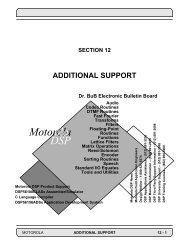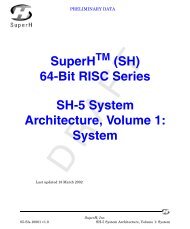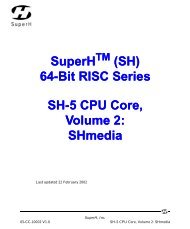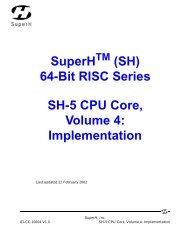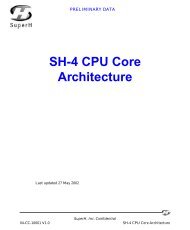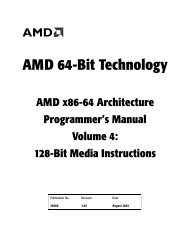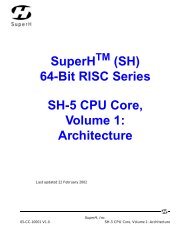SuperH (SH) 64-bit RISC Series SH-5 System Architecture, Volume ...
SuperH (SH) 64-bit RISC Series SH-5 System Architecture, Volume ...
SuperH (SH) 64-bit RISC Series SH-5 System Architecture, Volume ...
Create successful ePaper yourself
Turn your PDF publications into a flip-book with our unique Google optimized e-Paper software.
PRELIMINARY DATA<br />
202 <strong>SH</strong>debug link<br />
3.2.4 Clocking<br />
The data provided by the <strong>SH</strong>-5 on the DM_OSYNC and DM_OUT[3:0] pins is stable on the<br />
rising edge of DM_CLKOUT.<br />
The <strong>SH</strong>-5 debug module divides down the bus clock to provides the DM_CLKOUT clock<br />
source for the <strong>SH</strong>debug link. The divider has a power-on default value of 0xFFFF,<br />
giving a <strong>SH</strong>debug link clock frequency of approximately 3 kHz with a bus clock<br />
speed of 200 MHz. The divider is a field in memory-mapped register DM.CLKOUTDIV,<br />
which can be changed by host debug software. Debug software must have knowledge<br />
of the bus clock frequency and the maximum operating speed of the debug adapter<br />
before changing the divider value.<br />
In the initial <strong>SH</strong>-5 evaluation device implementation, the divider cannot be set to<br />
give a division smaller than 2. With a bus clock frequency of 200 MHz, a value of 2<br />
gives a debug-link clock speed of 100 MHz.<br />
In some applications, the CPU and bus clock frequencies can be dynamically<br />
changed by power-management software. By deriving the <strong>SH</strong>debug link clock from<br />
bus clock, the <strong>SH</strong>debug link clock speed automatically follows changes in bus clock<br />
speed allowing <strong>SH</strong>debug link communication to be maintained over any bus speed<br />
range. When <strong>SH</strong>-5 enters standby state, both the PLL and the master oscillator are<br />
disabled which means that the DM_CLKOUT signal assumes a steady DC level. The<br />
tool should monitor the STATUS0 and STATUS1 signals to determine when <strong>SH</strong>-5 has<br />
entered standby state.<br />
A tool can issue a command to wake up <strong>SH</strong>-5 from standby state. However, once the<br />
wake-up command has been issued, it can take up to a millisecond for the PLL to<br />
stabilize and internal clocks to be enabled. The tool must therefore monitor the<br />
STATUS0 and STATUS1 signals and delay any DBUS requests until the chip is<br />
operating normally.<br />
The input clock, DM_CLKIN, is independent of the output clock and is used by the<br />
debug module to extract serial data from the DM_IN and DM_ISYNC pins.<br />
D R A FT<br />
At high clock speeds, the design of the debug adapter must ensure that the<br />
DM_CLKIN, DM_IN and DM_ISYNC signals all have approximately the same I/O pad<br />
delays and interconnect delays. The frequency of DM_CLKIN may be higher or lower<br />
than the frequency of DM_CLKOUT up to the maximum permitted by the electrical<br />
specification of <strong>SH</strong>-5.<br />
<strong>SuperH</strong>, Inc.<br />
<strong>SH</strong>-5 <strong>System</strong> <strong>Architecture</strong>, <strong>Volume</strong> 3: Debug 05-SA-10003 v1.0



